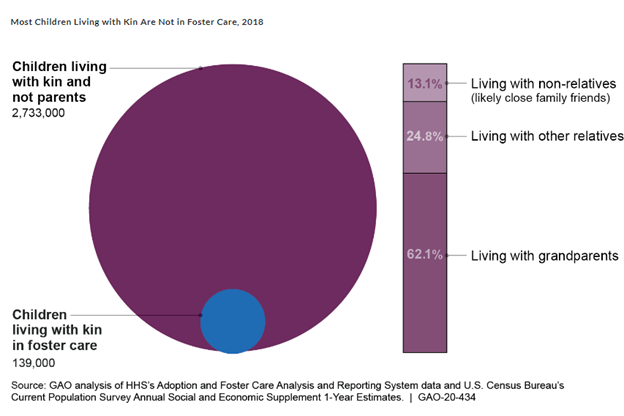Kinship/Grandfamilies Data

National Sources for Kinship/Grandfamilies Data
There are three main sources of data on kinship/grandfamilies at the national level: the U.S. Census Bureau, the Adoption and Foster Care Analysis and Reporting System (AFCARS), and the Annie E. Casey Foundation Kids Count Data Center. All of these data sources provide state-level data and, as noted, data for tribes, Puerto Rico, and the U.S. Virgin Islands.
Children in Kinship/Grandfamilies
As of September 2023, over 2.4 million children are being raised in kinship/grandfamilies in the United States.
The Annie E. Casey Foundation Kids Count Data Center, using data from the U.S. Census Bureau, calculates the number of children in “kinship care,” meaning grandchildren being raised by grandparents, other relatives, and close family friends with no parents in the home. This is the source that we at the Network use to refer to the number of children being raised in kinship/grandfamilies.
To find this data, go to the “Children in Kinship Care in United States” page of the Annie E. Casey Foundation Kids Count Data Center website. National data appears automatically. You can select your state or the District of Columbia in the drop-down menu on the left-hand side of the screen and choose the years in which you are interested. Data for tribes, Puerto Rico, and the U.S. Virgin Islands is not available here.
Children in Homes Headed by Relatives
The U.S. Census Bureau reports data on children in homes headed by relatives, which refers to children who live in homes that their grandparents or other relatives own or rent.
In 2022, approximately 7.6 million children were living in homes headed by relatives, which cover a spectrum of situations, from multigenerational homes in which middle generation parents are primarily responsible for the caregiving to homes in which the parents are not present.
To find this data, go to Table S0901 – Children Characteristics on the U.S. Census Bureau website and combine the “grandchild” and “other relatives” designations under the “relationship to householder” category.
To find the data for your community, go to the “Filter” panel on the left-hand side of the screen, then click “Geography” and indicate your search criteria, which, among the choices, includes zip code, state, county, and/or American Indian reservations. At the top of the screen, you can choose a yearly or five-year estimate.
Grandchildren Raised by Grandparents
U.S. Census Bureau data is available for grandchildren whose grandparents are responsible for them with no parents present in the home. The Network and other national organizations consider this data to represent grandchildren raised by grandparents.
In 2022, about 1 million grandchildren were raised by their grandparents with no parents present in the home.
Data on grandchildren is available by race, age, poverty status, whether they are native born or not, and whether the household receives public assistance. Similar data is not publicly available for children raised by other relatives or close family friends.
To find the grandchildren data, go to Table S1001 – Grandchildren Characteristics on the U.S. Census Bureau website.
To find the data for your community, go to the “Filter” panel on the left-hand side of the screen, then click “Geography” and indicate your search criteria, which, among the choices, includes zip code, state, county, and/or American Indian reservations. At the top of the screen, you can choose a yearly or five-year estimate. You will need to scroll right once on the chart to look for grandchildren whose grandparents are responsible for them and those grandchildren with no parents in the home.
Grandparents Raising Grandchildren
U.S. Census Bureau data is also available for grandparents who are responsible for their grandchildren. The Network and other national organizations consider this data to represent grandparents raising grandchildren.
In 2022, about 2.1 million grandparents were responsible for their grandchildren.
Data on grandparents is available by race, gender, marital status, labor force participation, whether they are native born or not, language, disability status, and poverty status. Similar data is not reported on other relatives or close family friends who raise children.
On February 26, 2024, the U.S. Census Bureau issued an updated report on Grandparents and Their Coresident Grandchildren using 2021 data; a previous report was published using 2012 data. Both reports address a variety of living arrangements. The most relevant to kinship/grandfamilies is when grandparents and grandchildren live together as “coresidents” in grandparent-maintained homes (meaning the grandparents own or rent the homes) and the grandparents are “responsible” for the grandchildren.
Please note that whether the grandparent considers themself “responsible” for the grandchild is subjective, self-reported information.
Notable 2021 data points from this report include:
- American Indian and Alaska Native and Black or African American grandparents were the most likely to be responsible for their grandchildren, with 39.2 and 38.2 percent of coresident grandparents responsible for their grandchildren, respectively.
- Grandparents were more likely to be responsible for their grandchildren for 5 years or longer in 2021 compared to 2012, and more of these grandparents are aged 60 and over than before – 59.5% of grandparents were aged 60 and over in 2021, an increase from 47% in 2012. “This shift towards older grandparents responsible for grandchildren continues a previously established trend,” according to the Census Bureau.
- 5 years or more was the most common length of time grandparents were responsible for grandchildren.
- Grandparents responsible for their grandchildren were more likely to live in the South and Midwest.
- Nationally, 18.3 percent of grandparents responsible for their coresident grandchildren lived in poverty. In the South, grandparents responsible for grandchildren were more likely to live below the poverty line than in other regions of the country.
- About 63 percent of grandparents responsible for their grandchildren were women.
To find the latest 2022 grandparents data, go to Table S1002 – Grandparents on the U.S. Census Bureau data website.
To find the data for your community, go to the “Filter” panel on the left-hand side of the screen, then click “Geography” and indicate your search criteria, which, among the choices, includes zip code, state, county, and/or American Indian reservations. At the top of the screen, you can choose a yearly or five-year estimate. You will need to scroll right on the chart to look for the grandparents responsible for grandchildren total, and to see data by age groupings of 30 to 59 years old and age 60 and older.
Although data on non-grandparent kin caregivers is not typically publicly available, the U.S. Government Accountability Office analyzed data from 2018 to determine the percentage of children raised by grandparents, other relatives, and close family friends. See the report.

Children in Foster Care with Relatives
Each year, the U.S. Department of Health and Human Services releases a national Adoption and Foster Care Analysis and Reporting System (AFCARS) report, which includes the number of children in foster care with “relatives” and the percentage of children who exit foster care to adoption with their relative or who exit to guardianship. Over one-third of all children in foster care in the United States are being cared for by relatives.
In 2021, 133,873 children were in the care of relatives in foster care, 34% of those children exited foster care to a relative adoption, and 12% exited to guardianship.
States and territories report their data differently to AFCARS, according to their own policies. Some key differences in reporting make comparisons among jurisdictions difficult:
- The definition of “relative” is determined by each state or territory, and some do not include close family friends (also known as “fictive kin”) in their “relative” category.
- Some states and territories report all children in the child welfare agency’s legal custody who are placed with relatives, regardless of the relative’s status as a licensed foster parent, while others only report children who are placed with fully licensed relatives.
- Closely related to this last difference in reporting, in some states and territories, children must receive foster care maintenance payments to be counted for purposes of AFCARS. Most children in foster care with relatives do not receive these payments.
- Some state or territory data systems do not distinguish among their licensed foster parents regarding whether they are related to the child or not.
The latest national AFCARS report is available online.
Children in Foster Care with Relatives by State or Territory
The Annie E. Casey Foundation Kids Count Data Center, using AFCARS data, compiles and publishes data on the number of children in foster care with relatives for each state, and their percentage of all children in foster care. Remember that states and territories report this data differently, as noted above.
To find the data, go to the “Children in Foster Care by Placement Type in United States” page on the Annie E. Casey Foundation Kids Count Data Center website and refer to the “Foster Family Home – Relative” category. Select the nation or your state (including the District of Columbia) or territory (Puerto Rico and the U.S. Virgin Islands) in the drop-down menu on the left-hand side of the screen and choose the years in which you are interested.
Ratio of Children Inside Versus Outside Foster Care Being Raised in Kinship/Grandfamilies
Nationally, there are about 18 children being raised by kin outside of foster care for each child in foster care with relatives.
Generations United calculates this ratio by (1) subtracting the number of children placed in foster homes with relatives (from “Children in Foster Care by Placement Type in United States” from Kids Count) from the number of children in kinship care (from “Children in Kinship Care in United States” from Kids Count) and then (2) dividing that number by the number of children placed in foster homes with relatives (from “Children in Foster Care by Placement Type in United States” from Kids Count).
You can use these data sources to make similar calculations for individual states and the District of Columbia. Those ratios are also available on the GrandFacts Fact Sheets.
Youth Data
Although no kinship specific data is reported in the CDC Youth Risk Behavior Survey Data Summary Report 2011-21, this data can be helpful to informing overall services and supports for youth. The Report includes data specifically concerning youth well being among 8th, 10th, and 12th graders who identify as American Indian/Alaska Native. This data is collected in public middle and high schools across the United States every other year. Because 92% of all American Indian/Alaskan Native youth are enrolled in public schools across the U.S., it gives a good snapshot on the concerns this unique group of youth are facing – data that is still too rare.